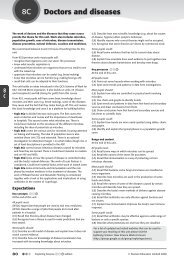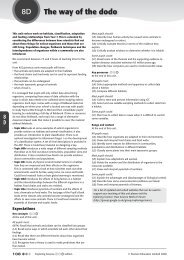8E TEACHER GUIDE.pdf - swallowhillresources
8E TEACHER GUIDE.pdf - swallowhillresources
8E TEACHER GUIDE.pdf - swallowhillresources
- No tags were found...
You also want an ePaper? Increase the reach of your titles
YUMPU automatically turns print PDFs into web optimized ePapers that Google loves.
Salt of the Earth<strong>8E</strong>c• Could: ask pupils to work in groups to plan their own method, andto explain the reasons for each step. Eye protection must be worn. Do NOT heat the salt to dryness inthe evaporating basin. Hot specks of salt will spit out. Stop heatingwhen crystals are forming at the edge and let the lastof the water evaporate without heating.Resources (per group)Rock salt, or a variety of rock salt samples (see below); accessto electronic top pan balance; mortar and pestle; evaporatingbasin; filter funnels and papers; beaker; conical flask; stirringrod; heating apparatus; eye protection; Worksheet <strong>8E</strong>c(5).‘Mine’ 4 1 6 3 5 2sand (g) 975 900 850 800 750 700salt (g) 25 100 150 200 250 300If possible, different grades and/or colours of sand should be used toalter the appearance of the samples.3: Practical: Testing water for hardness (AT)Ask pupils to test different samples of water for hardness, by shakingup a sample of water with some soap solution and measuring theheight of the lather produced. Pupils will have seen what happensif you have carried out Starter 2. If this has not been done, the firstAT presentation link on page 69 opens Testing water for hardness– which shows the effects of adding different quantities of soapsolution to different water samples. Pupils should discuss how tomeasure the results of the practical and how the observations areappropriate to the task.• Must: show pupils what to do, and ask them to test and rank thesamples in terms of hardness.• Should: ask pupils to plan a fair, quantitative investigation, andwrite a report stating the relative hardness of the different samplesin terms of the height of lather formed.Resources (per group)Numbered water samples made up using distilled waterand calcium sulphate (see below); boiling tubes; measuringcylinders; soap solution; ruler.Water sample 5 1 3 2 4 5Mass of calciumsulphate per litre (mg)0 40 80 120 160 1804: Salts in water AB/ATThe AT spreadsheet link on page 69 opens Salts in water – whichprovides details of the masses of different salts found in differentsamples of water. Pupils are asked to use this to plot different kindsof chart to compare the different waters and to decide which kind ofchart shows the data most effectively.Explaining tasks1: Practical: EvaporatingDemonstrate or let pupils practise evaporation of a solution todryness. Instructions are provided on Worksheet <strong>8E</strong>c(4).Heat a solution until a little remains so that the solid can be formedas the heat stored in the watch glass or evaporating basin evaporatesthis remaining amount. This will stop the solid residue from ‘spitting’at the pupils and also limit the number of breakages! This process isknown as heating to dryness. If the solid is heated beyond this point,it may ‘jump’ out of the container and be changed by the heat. Copper sulphate is harmful when solid or in concentratedsolution. Eye protection must be worn.Resources (per group)Evaporating basin; copper sulphate solution; heating apparatus;beaker; eye protection; Bunsen burners; Worksheet <strong>8E</strong>c(4).2: Pupil’s Book pages 68–69 (AB/AT)These pages explain that almost all water contains some dissolvedsalts, and introduces evaporation as a way of finding out howmuch salt is in the water. Worksheet <strong>8E</strong>(1) is the Access Sheet.• The AT video link on page 69 opens Hard and soft water – thevideo shows Tina Dijkstal talking about why some areas havehard water and some have soft water.• The first AT presentation link on page 69 opens Testing water forhardness – see Exploring 3.• The AT spreadsheet link on page 69 opens Salts in water – seeExploring 4.• The third AT presentation link on page 69 opens Extracting salt– see Plenary 2.• The first AT document link on page 69 opens Solution mining –see Plenary 3.3: Practical: Modelling filtration and evaporation (demonstration)This demonstration can be linked to Exploring 2 which asks pupils toextract salt from rock salt. Show pupils a mixture of flour, powderedcopper sulphate and dried pea or lentils. The flour represents thewater, the copper sulphate is the salt and the peas represent thesand and dirt. Shake the mixture in a sieve, collecting the flour andcopper sulphate in a basin below. Pupils should understand that thesieve is acting as the filter paper would. Ask pupils to think about thisas a model and to relate it to their knowledge of particles.Resources (per demonstration)Flour, powdered copper sulphate (or other coloured powder),dried peas or lentils, sieve, basin.Plenaries1: Quick CheckThe <strong>8E</strong> Quick Check sheet contains a set of cards that can be sortedto describe how to separate salt from rock salt, and to explain whathappens at each stage. These should be cut up beforehand. Pupilscan sort the cards individually or in groups.2: Extracting salt ATThe third AT presentation link on page 69 opens Extracting salt – thisshows two groups of pupils extracting salt from rock salt.Show pupils all the cartoons, and ask them to note on the final onewhich group has produced the most salt from their original sampleof rock salt (Group A). Then go through the cartoons again one byone, asking what Group A did better than Group B, and why thiswould make a difference. This is an opportunity to revise aspects ofdissolving and filtering as well as evaporation.3: Solution mining ATThe first AT document link on page 69 opens Solution mining – thispresents a diagram of solution mining, and poses questions aimed atrevising aspects of dissolving and evaporation.4: I can… cloze exercise AB/ATAfl The AB document link on page 69 opens a cloze exercisecovering the material on pages 68–69. There is also an ATpresentation version with answers.Homework tasks1: Worksheet <strong>8E</strong>e(7) provides simple questions on hard water.2: Worksheet <strong>8E</strong>e(8) provides questions on hard water, with anelement of comprehension.3: Worksheet <strong>8E</strong>c(9) looks at Gandhi and the Salt Act.<strong>8E</strong>c© Pearson Education Limited 2008 Exploring Science edition 149






